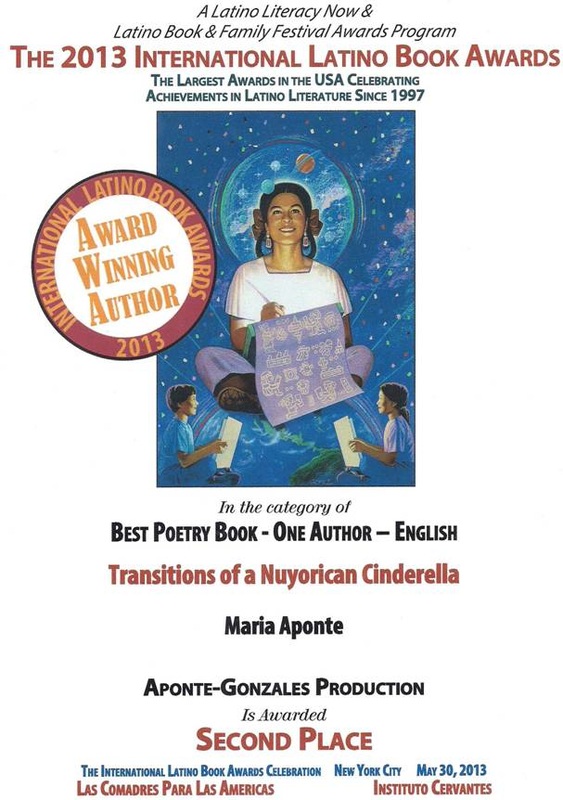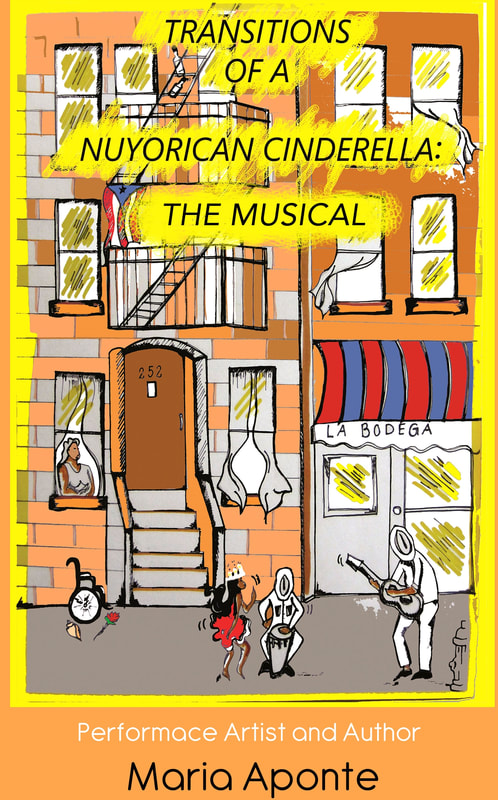Book Review by Aurturo CondeUnivision News June 5, 2012
Bookmarked: Maria Aponte’s ‘Transitions of a Nuyorican Cinderella’ Aponte’s readings often have a musical component to them. By ARTURO CONDE “The first time I put something to paper was with a #2 pencil, riding on the #4 train from the Bronx to Manhattan,” writes the Puerto Rican poet Maria Aponte in her first book, Transitions of a Nuyorican Cinderella. The year was 1979, and the paper was a brown bag from the bodega. Aristotle said that poets, unlike historians, tell general truths about things that might happen. And Aponte’s lyrical narrative is like an epic poem that describes the possible lives of hundreds, if not thousands, of Latino immigrants who live in perpetual movement between their home countries and the United States. Puerto Ricans, of course, are technically not immigrants; they are American citizens since 1917. But the experience of being uprooted economically, socially, and culturally from one place to another is the same. During the 19th and 20th centuries, New York was a city where immigrants from different backgrounds were compelled to write the histories of their homelands. Preserving one’s origin was a prerogative in a cavernous and industrial metropolis where it was easy to lose one’s identity. And for Puerto Ricans, Transitions of a Nuyorican Cinderella will recall the spirit of other immigrant accounts, like the 1984 Memoirs of Bernardo Vega by Cesar Iglesias, which offers insightful descriptions of Boricua and Latino life in New York during the early 20th century. Aponte’s book is a lyrical collection of poems, character and neighborhood profiles, and short stories about the Puerto Rican diaspora in New York. Aponte herself grew up a single child in 1960s East Harlem (“El Barrio”) and later, she moved to the Bronx in the 1980s, where she became a caregiver to her terminally ill mother. The theater became her safe place, and now in her mid-50s, Aponte is an accomplished poet, performance artist, and playwright; and an educator/academic counselor at Fordham University. Her one-woman show, Lagrimas de mis Madres, a biography of the women in her family, has toured the country since its debut in 1996. Transitions of a Nuyorican Cinderella opens with the narrative poem “Cruce el Agua,” which describes the primal instinct that draws immigrants back to their homeland. The protagonist, who is later identified as Rosa, could be any small town Puerto Rican housewife who migrated during the 20th century to the Lower East Side and Spanish Harlem in Manhattan, or further north to other enclaves in the Bronx. Squeezing small gandule beans in her palm, Rosa feels the weight of her life bending her shoulders as she contemplates leaving her small town of Coamo in Puerto Rico for New York, and she wrestles with the obligation of maintaining the traditions that she inherited directly from her mother. But it is at that extreme moment of vulnerability that she makes a heroic promise to never forget her family’s finca in Coamo, and resolves like many other Latino mothers to mine her children’s imagination and education in New York with stories of Puerto Rico. At times, Aponte’s book reads like the universal story of all immigrants in spite of cultural differences. In “The Clothesline of the Rosas,” a Puerto Rican and an Italian immigrant in Spanish Harlem are able to find common ground in their everyday household chores. Aponte describes the creaking sound that the clotheslines make when the women pull their laundry in as a coded message that helps them understand their shared plight as immigrants. In her first book, Aponte offers a colorful collection of poems and prose on the Puerto Rican diaspora in New York. Aponte also describes the displacement that many immigrants feel after they are uprooted from their homes and culture. In the poem “Abuela’s Plant,” a houseplant growing from eggshells, old Café Bustelo coffee grinds, water, and sunshine helps the narrator regain a sense of familiarity, comfort, and faith, in a concrete and asphalt city that is otherwise impersonal to her. Other lyrical profiles and character sketches are like small colored tiles in a much larger mosaic that depicts the solitude, introspection, sadness, and hope of all immigrants. Aponte describes the wrinkled but dedicated hands of a Puerto Rican woman flowing gently through white flour to make dough, while she simmers meat with tomato sauce, sofrito and recao to satisfy the demanding appetite of her husband. In another sketch, the poet describes a woman who recalls being driven with her girlfriends in polished Cadillacs, Pontiacs, and Thunderbirds to concert halls where they danced to popular mambos, cha-chas, and boleros that were popular during the 1950s and 1960s. But perhaps the moment that will resonate most with Latino readers is described in the narrative street life sketch “A Question.” When a man challenges the protagonist’s Puerto Rican identity because she looks black, the woman captures poetically how Latinos do not have only one culture or race but many: “I am a mixture of spices grown in warm, rich climates. I am the smell of tropical flowers that grow in lush green hills. I am Indian. I am African. I am Spaniard.” The greatest accomplishment of Aponte’s book is how it finds beauty in modest places, and it preserves and exalts the dream of a better life for younger generations of Latino immigrants. In the short story “White Carnations,” which closes the book, Aponte reimagines New York through the lens of a fairy tale: “Once upon a time, in a land far away, there was a small kingdom called the Bronx.” In this story, Linda arranges white carnations that remind her of the brilliant stars in the summer night sky. Those stars reflect the dreams of thousands if not millions of Latino immigrants who yearn to escape from the hardships of everyday life. And by the end of the tale, Linda is transformed from a lonely, marginalized woman to a modern day Cinderella who dances slowly with her tall dark prince Carlos at the Hunts Point Palace in the Bronx. As for why she decided to go with a fairy tale theme, Aponte explains on this recent interview on BronxNet Community TV that she wanted to honor Latina women. “I wanted us to be there, that’s always been my work, even when I started in theater in the 70s.” |
Amazon Reviews

